List of largest lakes and seas in the Solar System facts for kids
Our Solar System is full of amazing places, and some of the most exciting are the oceans, lakes, and seas! While we often think of Earth as the only watery world, scientists have discovered many other places with liquids, even if they are hidden. This article explores the biggest known or predicted bodies of liquid in our Solar System and beyond.
On Earth, we have vast oceans of liquid water right on the surface. But in other parts of the Solar System, most liquids are found under thick layers of ice. For example, Saturn's moon Titan has lakes of liquid hydrocarbons on its surface, which are like natural gas and oil.
Many moons of Jupiter and Saturn are thought to hide huge oceans of water deep beneath their icy crusts. Ganymede, Jupiter's largest moon, might have more water than all of Earth's oceans combined! Another Jupiter moon, Europa, also has a massive underground ocean. Scientists are very interested in these hidden oceans because they could potentially support life. Recent studies, using data from the James Webb Space Telescope, suggest that the carbon dioxide on Europa's surface might come from its subsurface ocean, making it a possible place for life to exist.
Other icy worlds like Callisto (another moon of Jupiter), Enceladus (a moon of Saturn), and even the dwarf planet Pluto are believed to have hidden oceans. These oceans are often kept liquid by heat from inside the moon or planet.
Besides water, some places have lakes of other liquids. For instance, Jupiter's moon Io has active volcanoes and lakes made of molten lava. Scientists are also looking for oceans on planets outside our Solar System, called exoplanets. It's possible that many exoplanets have hidden oceans too!
Largest Oceans, Lakes, and Seas in the Solar System
This table lists the largest known or predicted bodies of liquid. They are grouped by the celestial body they are found on.
| Body | Type of object | Volume (zettaliters) | Ocean/Lake/Sea | Composition | Location | Area (km2) | Average depth (km) | Image | Notes |
|---|---|---|---|---|---|---|---|---|---|
| Earth | planet | 1.362 | World Ocean | Salt water | Surface, global | 361,300,000 | 3.68 (max 11.02) | 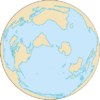 |
Covers 71% of Earth's surface. |
| Caspian Sea | Salt water | Surface, Central Asia | 389,000 | 0.21 (max 1.02) | 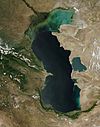 |
Earth's largest inland body of water. | |||
| Lake Michigan–Huron | Fresh water | Surface, North America | 117,400 | 0.07 (max 0.28) |  |
The largest freshwater lake on Earth. | |||
| Mars | planet | ? | South polar lakes? | Salt water or brine? | Under ice, south pole | c. 200 | (shallow) | 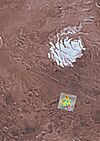 |
Scientists think there might be lakes under the ice at the south pole. |
| Io | moon of Jupiter | ? | Gish Bar Patera | Lava | Surface | 9,600 | ? |  |
One of Io's many active lava lakes. |
| Loki Patera | Lava | Surface | < 32,000 | ? | 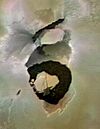 |
The largest volcanic depression on Io. | |||
| Europa | moon of Jupiter | 2.6 | Global Ocean | Water | Subsurface, global | c. 30,000,000 | est. 50–100 | 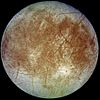 |
A huge ocean under 10 to 30 km of ice, possibly twice the volume of Earth's oceans. |
| Ganymede | moon of Jupiter | 35.4 | Global Ocean | Salt water | Subsurface, global | c. 80,000,000 | 100 | 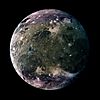 |
This ocean is under 150 km of ice and could be six times larger than Earth's oceans. It might even have several layers of oceans! |
| Callisto | moon of Jupiter | 5.3 | Global Ocean | Water | Subsurface, global | c. 65,000,000 | 10 | An ocean under 135 to 150 km of ice. | |
| Enceladus | moon of Saturn | 0.01 | Global Ocean | Salt water | Subsurface, global | c. 650,000 | 26–31 or 38 ± 4 | A global ocean under 21–26 km of ice. | |
| Titan | moon of Saturn | 18.6 | Kraken Mare | Hydrocarbons | Surface, north pole | ≈ 400,000 | 0.85 (max) | 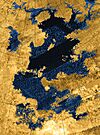 |
The largest known body of surface liquid outside Earth's oceans. |
| Ligeia Mare | Methane, ethane, nitrogen | Surface, north pole | 126,000 | ~0.2 |  |
The second largest lake on Titan. | |||
| Punga Mare | Hydrocarbons | Surface, north pole | 61,000 | ~0.11 |  |
A large lake of hydrocarbons. | |||
| Global Ocean | Water | Subsurface, global | c. 80,000,000 | < 300 | A global ocean of water under less than 100 km of ice. | ||||
| Triton | moon of Neptune | 0.03 | Global Ocean | Water | Subsurface, global | c. 20,000,000 | c. 150–200 | A likely global ocean under 150–200 km of ice. | |
| Pluto | dwarf planet | 1 | Global Ocean | Water | Subsurface, global | c. 10,000,000–15,000,000 | c. 100–180 | A possible global ocean under 150–230 km of ice. |
See also
- List of Solar System extremes
- Hydrosphere
- List of lakes by area
- Tidal heating

